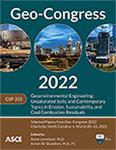CFD-DEM Simulation of Some Erosion Applications
Publication: Geo-Congress 2022
ABSTRACT
Since its emergence by Cundall in 1971, the Discrete Element Method (DEM) proved its efficiency in simulation and explanation of particulate media micro behaviors. The erosion process is the result of micro-interaction between fluid and soil particles. By parallelizing the Computational Fluid Dynamics (CFD) method with the DEM to simulate fluid action on the soil particles, erosion can be simulated at the particle scale. This paper presents a study of CFD-DEM applications in the simulation of erosion. The research focuses on the CFD-DEM technique to explore the fundamental erosion mechanisms in the Erosion Function Apparatus (EFA) test. One of the problems in soil erosion that needs to be investigated is the particles’ incipient motion. A three-dimensional CFD-DEM model is utilized to simulate the EFA simulation to derive velocity-based and shear stress-based erosion functions. The results of the above-mentioned numerical simulations are in good agreement with the laboratory test measurements, which indicates the potential accuracy and reliability of the CFD-DEM technique in simulating erosion at the particle scale and applying the result to full-scale problems.
Get full access to this article
View all available purchase options and get full access to this chapter.
REFERENCES
Abdelhamid, Y., and El Shamy, U. (2014). Pore‐scale modeling of surface erosion in a particle bed. International Journal for Numerical and Analytical Methods in Geomechanics, 38(2), 142–166.
Abdelhamid, Y., and El Shamy, U. (2015). Pore-scale modeling of fine-particle migration in granular filters. International Journal of Geomechanics, 16(3), 04015086.
Cundall, P. A. (1971). A computer model for simulating progressive, large-scale movement in blocky rock system. In Proceedings of the International Symposium on Rock Mechanics, 1971.
Fannin, J. (2008). Karl Terzaghi: from theory to practice in geotechnical filter design. Journal of geotechnical and geoenvironmental engineering, 134(3), 267–276.
Guo, Y., and Yu, X. (2018). Analysis of surface erosion of cohesionless soils using a three-dimensional coupled computational fluid dynamics–discrete element method (CFD–DEM) model. Canadian Geotechnical Journal, 56(5), 687–698.
Honjo, Y., and Veneziano, D. (1989). Improved filter criterion for cohesionless soils. Journal of Geotechnical Engineering, 115(1), 75–94.
Indraratna, B., Dilema, E. L. G., and Vafai, F. (1996). An experimental study of the filtration of a lateritic clay slurry by sand filters. Proceedings of the Institution of Civil Engineers-Geotechnical Engineering, 119(2), 75–83.
Itasca, C. G. I. (2008). PFC3D (Particle Flow Code in 3 Dimensions), Version 4.0. Minneapolis: ICG, 3.
Kanitz, M., and Grabe, J. (2019). Multiscale investigation of suffusion with coupled CFD-DEM-Influence of different drag force models. 2nd International Conference on the Material Point Method for Modelling Soil-Water-Structure Interaction, At Cambridge, United Kingdom.
Norouzi, H. R., Zarghami, R., Sotudeh-Gharebagh, R., and Mostoufi, N. (2016). Coupled CFD-DEM modeling: formulation, implementation and application to multiphase flows. John Wiley & Sons.
Schiller, L., and Naumann, A. (1933). “Ueber die grundlegenden Berechnungen bei der Schwerkraftaufbereitung”, VDI Zeits., 77(12), pp. 318–320.
Shafii, I., Zhang, Z., and Briaud, J. L., (2018). Measurement of Hydrodynamic Forces on Gravel Particles in the Erosion Function Apparatus. The 9th International Conference on Scour and Erosion, Taipei, Taiwan.
Sherard, J. L., and Dunnigan, L. P. (1989). Critical filters for impervious soils. Journal of Geotechnical Engineering, 115(7), 927–947.
Sherard, J. L., Dunnigan, L. P., and Talbot, J. R. (1984). Basic properties of sand and gravel filters. Journal of Geotechnical Engineering, 110(6), 684–700.
Sherard, J. L., Dunnigan, L. P., and Talbot, J. R. (1984). Filters for silts and clays. Journal of Geotechnical Engineering, 110(6), 701–718.
Siemens, P. L. M. (2017). STAR-CCM+ Documentation. Siemens PLM Software Inc, 12.
Sun, R., and Xiao, H. (2016). CFD–DEM simulations of current-induced dune formation and morphological evolution. Advances in water resources, 92, 228–239.
Tao, H., and Tao, J. (2017). Quantitative analysis of piping erosion micro-mechanisms with coupled CFD and DEM method. Acta Geotechnica, 12(3), 573–592.
USACE. (1953). “Filter experiments and design criteria.”, Waterway Experiment Station,Vicksburg, MS.
Vanoni, V. A. (2006). Sedimentation engineering: American Society of Civil Engineers,.
Vaughan, P. R., and Hermusla, S. F. (2009). Design of filters for clay cores of dams. In Selected papers on geotechnical engineering by PR Vaughan (pp. 121–135). Thomas Telford Publishing.
Wang, Y., Zhou, L., and Yang, Q. (2019). Hydro-mechanical analysis of calcareous sand with a new shape-dependent fluid-particle drag model integrated into CFD-DEM coupling program. Powder Technology, 344, 108–120.
Zhang, D. M., Gao, C. P., and Yin, Z. Y. (2019). CFD-DEM modeling of seepage erosion around shield tunnels. Tunneling and Underground Space Technology, 83, 60–72.
Zheng, H. C., Shi, Z. M., Peng, M., and Yu, S. B. (2018). Coupled CFD-DEM model for the direct numerical simulation of sediment bed erosion by viscous shear flow. Engineering geology, 245, 309–321.
Information & Authors
Information
Published In
Copyright
© 2020 ASCE.
History
Published online: Mar 17, 2022
Authors
Metrics & Citations
Metrics
Citations
Download citation
If you have the appropriate software installed, you can download article citation data to the citation manager of your choice. Simply select your manager software from the list below and click Download.
